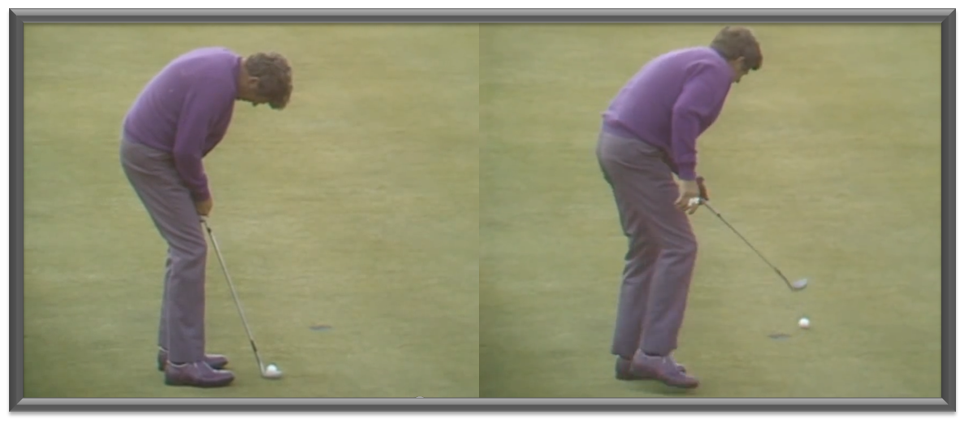Choking under pressure is a phenomenon that every elite player has experienced but few are willing to explore their personal episodes of choking and analyze the causes of this adverse and costly reaction to perceived pressure.
Most players would rather erase such experiences from their mind, and hope it never happens again. But recognizing your patterns of response in terms of thought and action, and understanding what needs to change can mean the difference between being a choking resistant player or a choking susceptible player.
In this article, I will share the elite player profiles emerging in recent research on choking susceptibility, that can guide the self-assessment of your player profile to better understand yourself and your typical response under pressure.

Doug Sanders misses this short putt to win the 1970 Open Championship and loses in a play-off to Jack Nicklaus the next day.
Choking Defined:
CHOKING is define as a critical deterioration in skill execution leading to substandard performance that is caused by an elevation in anxiety levels under pressure at a time when a successful outcome is attainable by the athlete.
In contrast, the CLUTCH performance is seen as an increment or superior performance that occurs under pressure circumstances.
Familiar Examples of Choking:
Many players associate choking with Norman’s devastating finish in the 1996 Masters after going into the final round with 6-shot lead over Faldo.
In 2011 at the Masters, Rory McIlroy began the final round with a 4-stroke lead. But he fell apart beginning on the 10th tee, eventually finishing with an 80 to drop to 15th place.
His drive on No. 10 wound up between two of Augusta Nationals cabins, a part of the course that might never have been shown on TV before. He triple-bogied that hole, and followed it with a bogey on the 11th and a double on the 12th.
Now let’s take a closer look at what happen’s behind the choking event in terms of common thought patterns and on-course behavioural responses.
The published research Dr Gucciardi and I conducted in 2010 examined the individual choking experiences of 30 elite players from Australia and the US.
These are the common patterns seen in their responses.
Thoughts and Focus
- An unyielding focus on the score / scoring (scoring well)
- Lack of clarity / indecision, and reduced commitment in shot selection
- Frequent self-criticism
- Excessive self-focus
The literature indicates that an excessive self-focus is linked to a form of “self-talk” that is unproductive, self-berating, and dwells on mistakes. It keeps a players focus inward (lost in thought), leading to exaggeration of emotional experiences, preventing the individual from focusing on the task, the target, and what’s happening around them, which ultimately leads to poor decision making.
Common Behavioral Responses (Actions):
- Swing/Grip Tension – Tempo change.
- Departure from normal routines.
- Emotional outbursts.
- A change in interactions with playing partners or caddy.
Are you a Choking Resistant Player or a Choking Susceptible Player?
The Profile of a Choking Susceptible Player:
The latest research in choking behaviors and cognitions provide insight into the profile of a choking susceptible athlete.
The following attributes are related to choking susceptibility.
High Trait Anxiety
This involves the experience of anxiety not just on the golf course, but also in other daily tasks such as, social gatherings or exams.
A Strong Self-Focus
A habit of monitoring your thoughts and feelings in most social situations.
High Self-Consciousness
Excessive worry about what other’s think and how they perceive you.
Rigidity and inflexibility in your training and game approach
This means you are the type of player who does not cope well with change or adapt easily to unforeseen circumstances. In training, you enjoy repetitive drills in for skill mastery, but dislike practice that forces a new or creative approach.
Symptoms of high stress before major competitions
This means that deep down your mind and body perceive pressure situations as a threat and you do not find these moments fun or energizing.
The Profile of the Choking Resistant Player:
In contrast, the profile of a choking resistant player is defined by these actions and characteristics:
Engagement in Optimistic Self-talk
Following a bad hole, choking resistant players consistently remind themselves of positive possibilities.
Their self-talk directs their focus on playing “one shot at a time.”
Visualization of team support
Interestingly, choking resistant players imagine significant others cheering them on when they walk the course, rather than worrying about how other’s perceive them.
A Pre-shot Routine that Regulates Arousal
Resistant players perform an action in their pre-shot routine that helps to set their focus or calm their nerves. Ask yourself: Do the actions in your routine serve a purpose?
A Present Focus
Instead of focusing on past mistakes or future failures your mind and body is absorbed in the present shot.
Reduced Expectations
This involves a healthy perspective and a positive outlook on the importance of your performance in the upcoming tournament.
Trusting and Instinctual.
This involves a strong sense of trust in your abilities as a player, allowing you to feel natural on the course, and play instinctually.
Utilize these profiles to identify areas for improvement in your own player profile, as well as attributes you would like to optimize to enhance your performance under pressure.
To further develop your choking resistant mental skills make an appointment with Dr Jay-Lee.







